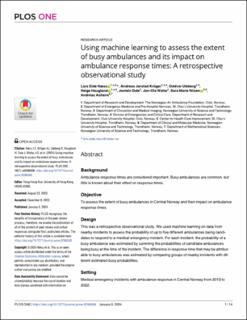| dc.contributor.author | Næss, Lars Eide | |
| dc.contributor.author | Krüger, Andreas Jørstad | |
| dc.contributor.author | Uleberg, Oddvar | |
| dc.contributor.author | Haugland, Helge | |
| dc.contributor.author | Dale, Jostein | |
| dc.contributor.author | Wattø, Jon-Ola | |
| dc.contributor.author | Nilsen, Sara Marie | |
| dc.contributor.author | Asheim, Andreas | |
| dc.date.accessioned | 2024-01-15T10:19:33Z | |
| dc.date.available | 2024-01-15T10:19:33Z | |
| dc.date.created | 2024-01-08T13:48:52Z | |
| dc.date.issued | 2024 | |
| dc.identifier.issn | 1932-6203 | |
| dc.identifier.uri | https://hdl.handle.net/11250/3111474 | |
| dc.description.abstract | Background
Ambulance response times are considered important. Busy ambulances are common, but little is known about their effect on response times.
Objective
To assess the extent of busy ambulances in Central Norway and their impact on ambulance response times.
Design
This was a retrospective observational study. We used machine learning on data from nearby incidents to assess the probability of up to five different ambulances being candidates to respond to a medical emergency incident. For each incident, the probability of a busy ambulance was estimated by summing the probabilities of candidate ambulances being busy at the time of the incident. The difference in response time that may be attributable to busy ambulances was estimated by comparing groups of nearby incidents with different estimated busy probabilities.
Setting
Medical emergency incidents with ambulance response in Central Norway from 2013 to 2022.
Main outcome measures
Prevalence of busy ambulances and differences in response times associated with busy ambulances.
Results
The estimated probability of busy ambulances for all 216,787 acute incidents with ambulance response was 26.7% (95% confidence interval (CI) 26.6 to 26.9). Comparing nearby incidents, each 10-percentage point increase in the probability of a busy ambulance was associated with a delay of 0.60 minutes (95% CI 0.58 to 0.62). For incidents in rural and urban areas, the probability of a busy ambulance was 21.6% (95% CI 21.5 to 21.8) and 35.0% (95% CI 34.8 to 35.2), respectively. The delay associated with a 10-percentage point increase in busy probability was 0.81 minutes (95% CI 0.78 to 0.84) and 0.30 minutes (95% CI 0.28 to 0.32), respectively.
Conclusion
Ambulances were often busy, which was associated with delayed ambulance response times. In rural areas, the probability of busy ambulances was lower, although the potentially longer delays when ambulances were busy made these areas more vulnerable. | en_US |
| dc.language.iso | eng | en_US |
| dc.publisher | Public Library of Science, PLOS | en_US |
| dc.rights | Navngivelse 4.0 Internasjonal | * |
| dc.rights.uri | http://creativecommons.org/licenses/by/4.0/deed.no | * |
| dc.title | Using machine learning to assess the extent of busy ambulances and its impact on ambulance response times: A retrospective observational study | en_US |
| dc.title.alternative | Using machine learning to assess the extent of busy ambulances and its impact on ambulance response times: A retrospective observational study | en_US |
| dc.type | Peer reviewed | en_US |
| dc.type | Journal article | en_US |
| dc.description.version | publishedVersion | en_US |
| dc.source.volume | 19 | en_US |
| dc.source.journal | PLOS ONE | en_US |
| dc.source.issue | 1 | en_US |
| dc.identifier.doi | 10.1371/journal.pone.0296308 | |
| dc.identifier.cristin | 2222366 | |
| dc.relation.project | Norges forskningsråd: 295989 | en_US |
| dc.source.articlenumber | e0296308 | en_US |
| cristin.ispublished | true | |
| cristin.fulltext | original | |
| cristin.qualitycode | 1 | |

